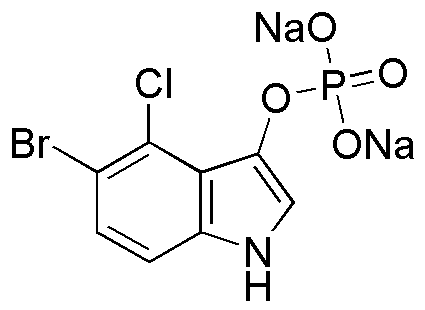5-Bromo-4-chloro-3-indolyl phosphate disodium salt is widely utilized in research focused on:
- Biochemical Assays: This compound serves as a substrate in enzyme assays, particularly for alkaline phosphatase, allowing researchers to measure enzyme activity effectively.
- Cellular Imaging: It is used in fluorescence microscopy to visualize cellular processes, providing insights into cell signaling and metabolic pathways.
- Drug Development: The compound aids in the screening of potential drug candidates by evaluating their effects on specific biochemical pathways, streamlining the drug discovery process.
- Genetic Research: It plays a crucial role in studying gene expression and regulation, helping scientists understand genetic mechanisms and their implications in diseases.
- Environmental Monitoring: This chemical can be applied in assays to detect phosphatase activity in environmental samples, assisting in the assessment of soil and water quality.
General Information
Properties
Safety and Regulations
Applications
5-Bromo-4-chloro-3-indolyl phosphate disodium salt is widely utilized in research focused on:
- Biochemical Assays: This compound serves as a substrate in enzyme assays, particularly for alkaline phosphatase, allowing researchers to measure enzyme activity effectively.
- Cellular Imaging: It is used in fluorescence microscopy to visualize cellular processes, providing insights into cell signaling and metabolic pathways.
- Drug Development: The compound aids in the screening of potential drug candidates by evaluating their effects on specific biochemical pathways, streamlining the drug discovery process.
- Genetic Research: It plays a crucial role in studying gene expression and regulation, helping scientists understand genetic mechanisms and their implications in diseases.
- Environmental Monitoring: This chemical can be applied in assays to detect phosphatase activity in environmental samples, assisting in the assessment of soil and water quality.
Documents
Safety Data Sheets (SDS)
The SDS provides comprehensive safety information on handling, storage, and disposal of the product.
Product Specification (PS)
The PS provides a comprehensive breakdown of the product’s properties, including chemical composition, physical state, purity, and storage requirements. It also details acceptable quality ranges and the product's intended applications.
Certificates of Analysis (COA)
Search for Certificates of Analysis (COA) by entering the products Lot Number. Lot and Batch Numbers can be found on a product’s label following the words ‘Lot’ or ‘Batch’.
*Catalog Number
*Lot Number
Certificates Of Origin (COO)
This COO confirms the country where the product was manufactured, and also details the materials and components used in it and whether it is derived from natural, synthetic, or other specific sources. This certificate may be required for customs, trade, and regulatory compliance.
*Catalog Number
*Lot Number
Safety Data Sheets (SDS)
The SDS provides comprehensive safety information on handling, storage, and disposal of the product.
DownloadProduct Specification (PS)
The PS provides a comprehensive breakdown of the product’s properties, including chemical composition, physical state, purity, and storage requirements. It also details acceptable quality ranges and the product's intended applications.
DownloadCertificates of Analysis (COA)
Search for Certificates of Analysis (COA) by entering the products Lot Number. Lot and Batch Numbers can be found on a product’s label following the words ‘Lot’ or ‘Batch’.
*Catalog Number
*Lot Number
Certificates Of Origin (COO)
This COO confirms the country where the product was manufactured, and also details the materials and components used in it and whether it is derived from natural, synthetic, or other specific sources. This certificate may be required for customs, trade, and regulatory compliance.


